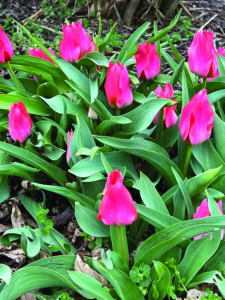
When looking at tulips, look for those labeled as perennial tulips which will thrive in the USDA zones of 3 to 8. (Photo by Ginny Rosenkranz)
April is finally warm enough to encourage the tulips to emerge from the ground and spread their beautiful, colorful rainbow of flowers.
Tulips are originally from Asia Minor where the wild ones still grow and bloom on the mountain slopes.
Tulips came to America in the 1600s, and by 1642 there were settlements in what is now Manhattan that were growing a lot of tulips that had been sent from Holland.
In 1951 the colorful and hardy Darwin hybrid tulips started to arrive in America.
Now you can purchase tulips at all of the box stores and garden centers in the late summer and you can even order them direct from Holland.
These bulbs need to have at least 12 weeks or more of really cold weather to bloom, and it is best to plant them in your garden in late fall.
The bulbs need to be placed so that at least 6 inches of soil is over top of the bulb with the pointed end upwards.
Both the tulip bulbs and the flowers are edible to voles, squirrels and deer, and they will love to eat all of your beautiful tulips.
You can protect the bulbs in the ground by planting them inside a bulb cage or by laying down a rodent proof wire mat over the bulbs.
A spritz of deer repellents can help to discourage the deer from feasting on the colorful tulips.
Please read the directions and be prepared to use a different repellent every other month.
That said, what types of tulips are best to plant on the Eastern Shore?
When looking at tulips, look for those labeled as perennial tulips which will thrive within the USDA zones of 3 to 8.
Those labeled as perennial can come back at least three years in a row, and sometimes even more.
Species tulips are small but very hardy and have continued to come up to bloom for up to 10 years.
Because the temperatures on the Shore can warm up quickly, the early spring and the mid-spring blooming tulips thrive the best and bloom the longest.
The Darwin hybrid Tulips are the longest lasting flowers on tall strong stems with brilliant colors, and are considered the best of the perennial tulips, blooming in mid-season.
Single early tulips bloom the earliest and come in wonderful rainbows of colors, blooming the longest due to the cooler weather.
Triumph Tulips have the widest range of colors with medium length stems, but are usually planted for the one season.
French single late Tulips are strong perennials with oblong shaped flowers that come to a pointed top. Their long stems make them excellent cutting tulips, and these varieties perform well on the Shore.
Double- and semi-double tulips that bloom early and mid-season will continue to bloom year after year for at least three years, while the late blooming varieties have a shorter life.
Fringed or “Crispa” tulips bloom from mid-season to late, providing lovely color and interesting textures.
Fosteriana tulips have exceptionally large and tall flower with vivid rich colors, blooming in early spring and are considered perennials.
Greigii tulips are also early and mid-season bloomers with purple striped foliage and bicolored flower petals that open wide during the day to share their bright colors.
Kaufmanniana tulips are very long-lived perennial tulips, blooming in early- to mid-season.
Some have striped foliage and all open in the heat of the day to create stars blooming in the garden.
Lily-Flowered tulips are late spring bloomers and are worth planting for their elegant and graceful flowers that have their pointed petals curving outwards.
Virdiflora tulips have a stripe of green on each white, pink or lavender colored petal, creating an exotic picture in the late spring flower beds.
Parrot Tulips bloom very late in spring but are really worth waiting for with their large blooms in brilliant, dramatic colored petals with scalloped or fringed tops.
They need protection from wind, snow and rain, so it might be best to plant them in containers.
Species tulips are usually the first to bloom in warm colors of yellows, oranges and reds on their short stems.
They too open to present colorful star shaped flowers that are best suited to the front of boarders or among small spring blooming plants like violas and pansies.
Kaufmanniana “Heart’s Delight”has alternating bright red petals edged in creamy white on the outside and open up to a star shaped flower of light pink with a golden center.
As the sun warms up the flowers in the morning the upright petals open up to create a cup to encourage the pollinators to visit.
As evening comes and the temperatures drop, the petals close again.
Another beautiful Kaufmanniana is “Showwinner” that has scarlet outer petals that open to a softer red and a golden center.
Although they are small compared to other tulips rising only grow 8-10 inches high, they come from a region that has very cold winters and hot dry summers and usually have a very long life here on Maryland’s Eastern Shore.
The Fosteriana tulips are also known as the Emperor Tulips, with their large elongated blooms that open to form a cup shaped flower with broad and slightly pointed petals.
The sturdy green stems hold these elegant flowers 10-2 inches above the ground and as some of the earliest bloomers, add vivid reds, oranges, yellows along with pastel pinks and creams to brighten up the landscape.
These beautiful flowers also come in bicolors, combining a red base with yellow edges or white petals with a splash of pink.
Some of the better known include “Red Emperor” with huge bright red petals that open to reveal a black heart.
“Yellow Purissima” has broad, elongated yellow petals edged with a brighter yellow and has been known to bloom for up to three weeks.
“Exotic Emperor” blooms early in spring with large double creamy white petals that are framed in bright green.
Like a lot of the Fosterianna tulips, they will naturalize and bloom year after year.
Darwin hybrid tulips bloom for at least 3 years and sometimes longer in our area.
They come in all the rainbow of colors from pure white to cream, the lightest pink to the darkest deepest reds.
Pale- to bright-yellows to the deep orange, except for black, but there are deep dark purple ones that can look almost black.
Some even are two-toned, mixing alternating yellow and red petals for a bright sunset look, or mixing soft pinks fading into darker pink.
The flower blooms fairly early and has a lovely bowl-shaped flower rising 24-26 inches high on study stems that emerge from the lance shaped deep green leaves.
Some of the favorites include “American Dream” that opens up to 6 inches wide with golden yellow petals edged in bright reddish orange.
“Pink Impression” has deep rose-colored petals edged with softer pink, and “Ollioules” has rose red petals that fade into ivory edges.
“Marit” has raspberry red petals that are outlined with primrose yellow, while “Daydream” has fragrant sunny yellow petals edged with apricot orange.
Another fragrant Darwin tulip is “Ad Rem,” with scarlet petals edged in golden yellow.
Spring may be chilly but the elegant beauty of the rainbow-colored tulips will always make a short walk to admire them well worth the time.
(Editor’s Note: Ginny Rosenkranz is a commercial horticulture specialist with the University of Maryland Extension.)



